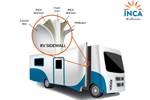Lanxess launches renewable, biocomposite material
The material combines natural flax fibers with bio-based polylactic acid, which acts as the matrix, for a material that is 100% recyclable.

Photo Credit: Lanxess
Lanxess (Cologne, Germany) launches a new, fully biocomposite material in its Tepex range of continuous fiber-reinforced thermoplastic composites, in an effort to remove the reliance of fossil fuels from its own production processes. The material combines natural flax fibers with bio-based polylactic acid, which acts as the matrix, and can be produced on a large scale.
Lanxess’ continuous fiber-reinforced fabrics are said to be lighter in weight than glass fibers — flax fibers have a lower density — and offer mechanical performances typical of Tepex, which is based chiefly on the continuous fibers arranged in particular directions. The weight-specific stiffness of the biocomposite is also comparable to that of glass fiber-reinforced material variants. Further, designing the composite components to suit the expected loads enables most of the force to be transferred via the continuous fibers, ensuring high strength and stiffness.
In addition to sports equipment applications, the new biocomposite can reportedly be used in cars, such as for manufacturing interior parts, or in electronics for the production of housing components.
The material can also be 100% recycled. Lanxess notes that offcuts and production waste can be regranulated and easily injection molded or extruded, either alone or mixed with unreinforced or short fiber-reinforced materials.
In the medium term, Lanxess is planning to use other bio-based thermoplastics such as polyamide 11 and other natural and recycled fibers for the production of Tepex.
Related Content
-
The lessons behind OceanGate
Carbon fiber composites faced much criticism in the wake of the OceanGate submersible accident. CW’s publisher Jeff Sloan explains that it’s not that simple.
-
TU Munich develops cuboidal conformable tanks using carbon fiber composites for increased hydrogen storage
Flat tank enabling standard platform for BEV and FCEV uses thermoplastic and thermoset composites, overwrapped skeleton design in pursuit of 25% more H2 storage.
-
Natural fiber composites: Growing to fit sustainability needs
Led by global and industry-wide sustainability goals, commercial interest in flax and hemp fiber-reinforced composites grows into higher-performance, higher-volume applications.
















